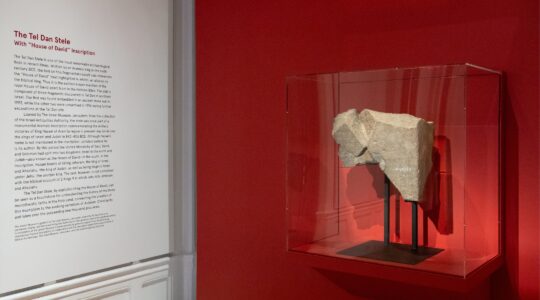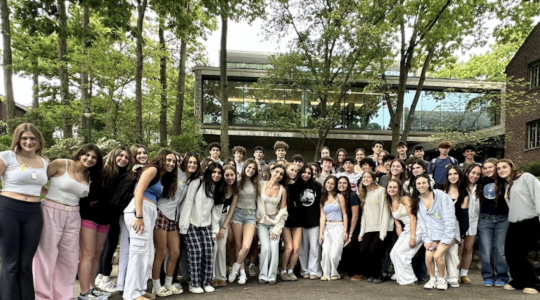Thousands of years from now, what will human conversation look like? Like the Talmud? A version of Wikipedia?
Last weekend I participated in two fascinating conversations that got me thinking about the future of conversation, and how both new technology and old Jewish ideas might give us a clue.
The first conversation, which I was privileged to host at the Contemporary Jewish Museum, was called The Long Conversation. A project of the Long Now Foundation, a San Francisco-based organization that “hopes to provide counterpoint to today’s ‘faster/cheaper’ mind set and promote ‘slower/better’ thinking,” this six-hour gabfest brought together leaders in the fields of technology, ecology, culture, business and religion to explore the myths and values of a civilization increasingly addicted to the short view of things.
Several hundred people attended, which was recorded on video and simultaneously analyzed with cutting-edge visual tools from SoSo Limited, an art and technology studio staffed by MIT grads.
The Long Conversation was remarkable for many reasons. First of all was the format. Each speaker had 30 minutes on stage; for 15 minutes each one interviewed someone, and then was interviewed by someone else. None of them had been in conversation before, and there was no set topic, goal or argument. In this way it parallels the “open source” conversation philosophy increasingly popular for companies and organizations (and the approach used by The Jewish Week for its yearly confab called simply “The Conversation,” which is taking place this week in Baltimore.)
This re-imagining of what 15 minutes of dialogue could feel like turned Andy Warhol’s pronouncement of a future in which everyone was famous for 15 minutes on its head. On the one hand, Warhol’s prognosis of a future built on 15 minutes seems to have come true (and how) with those hoping to have their YouTube video go viral. On the other hand, in the context of a leisurely, daylong conversation in which the whole programs was seen as a community-built dialogue, 15 minutes was shown to be sufficient for someone to dig into serious ideas.
Then there was the instant visual analysis of the conversation, an ongoing x-ray of the current conversation. These visual elements, superimposed upon the faces and voices of the speakers, created a layering affect that allowed one to see inside the grammar of dialogue. Visitors could track in real time such issues as the relative number of emotional vs. judgmental terms being used, or how many speakers said “me” vs. how many said “you,” or how many said “charity” vs. “business.”
Then there was how oddly Jewish it felt. There were 18 speakers (plus Long Now founder Stewart Brand, he of “The Whole Earth Catalog” fame), a Jewishly auspicious number. The pairings of two people, focused on the loftiest issues of the day, which recalled the intensity of traditional chevruta learning in the yeshiva.
The day’s participants — including NASA Ames Research Center Director Simon Worden, Wikipedia Foundation Chief Technology Officer Danese Cooper and Electronic Frontier Foundation co-founder John Perry Barlow — all expressed their gratitude at having a chance to talk more openly and more widely than usual.
The Long Now’s Foundation’s goal of having people take a step back from an automatic, reactive approach to society was given explicitly Jewish context from filmmaker and technologist Tiffany Shlain. She explained that the idea of the Sabbath as a day of rest and perspective had to start with their family’s technology, meaning that any conversations that were had on Shabbat could not include iPhones or Twitter.
The second conversation, in the library at my synagogue in Berkeley, was gave our rabbi, Menachem Creditor, a chance to share informal thoughts about a book he is writing about living a Jewish life in a postmodern age. Prominent in his thinking is the idea that people need to be in true conversation for community to happen, and that technology can aid these conversations. Rabbi Creditor is a power-user of blogs and e-mails, and he believes in the power of groups of people thinking and talking together to make the world a better place.
Rabbi Creditor described the synagogue conversation as “a page of Gemarah,” a living page of argument and talk that ranged across the same issues as the talkers of the Talmud: the land of Israel, the nature of Jewish laws, the connections between spirituality and politics. Indeed, as on a page of Talmud, we started with a piece of text, and people spun around it for hours, commenting on the text, then commenting on the commentary. What was most important that evening was the primacy of conversation itself; of a rabbi able to talk openly with congregants about theology, and of a community feeling open enough to talk back.
Support the New York Jewish Week
Our nonprofit newsroom depends on readers like you. Make a donation now to support independent Jewish journalism in New York.
Many people now talk about web-based conversation and collaboration as an ongoing, perhaps infinite dialogue – in essence suggesting that the nature of web-based communication, despite its users mania for instant answers, is setting itself up for the long haul. This parallels Rabbi Creditor’s idea that “the Talmud is actually a long conversation with no end in sight.” To paraphrase Pirkei Avot, we are not obligated to finish our conversation, but neither are we free to stop having it.
Daniel Schifrin is director of public programs and writer-in-residence at the Contemporary Jewish Museum.
The New York Jewish Week brings you the stories behind the headlines, keeping you connected to Jewish life in New York. Help sustain the reporting you trust by donating today.




